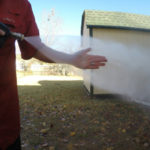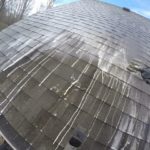The Difference Between Pressure Washing, Low Pressure Washing and Soft Washing
Pressure Washing
There are not very many differences between power washing and pressure washing; in fact some people consider them the same service. Pressure washing is done with the normal unheated temperature of water and uses the force of water to clean. True high pressure washing is manually removing the surface contaminates via the force of pressurized water and will blast away dirt, mild, mildew and other hazardous materials. It is recommended that this type of cleaning be used only on hard concrete areas such as sidewalks, driveways, patios and brick. When used on soft surfaces such as vinyl or stucco it can damage the surfaces and force water behind the surface possibly causing damage to the structure. Usually this type of cleaning can be seen with employees up on ladders cleaning high areas from just a few inches from the surface they are cleaning.
Low Pressure Cleaning
Low Pressure Washing uses a combination of blended chemicals/detergents/biocides to kill the green mold and mildew, letting that mixture sit on the surface long enough to do its job before it is rinsed off with low pressure. Low Pressure Washing involves streaming the soap mixture using a pressure of around 100 psi to apply and no more than 900 psi to rinse all the dead mold, mildew, dirt and unwanted materials away. A professional company knows how to blend the soap mixture to where there is no damage to surrounding plant life. One way you can tell a company uses low pressure technique is they are using the black tip to apply a soap mixture and when rinsing will stand back several feet from the surface and let the water volume do the rinsing. You can also put your bare hand in front of the water stream without damage to your skin. All of this can be done with a regular pressure washer machine with the right knowledge of RPM’s of your machine and the correct tips for your machine.

Soft Washing
Soft washing is the newest revolution in the industry. To understand the difference in the methods let’s look at the difference in equipment to start with. The simplest soft washing rig consists of just a few parts: the tank, the pump, the hose and finally the spray gun. There are more sophisticated configurations available, allowing for more options and wider mixes of differing soft wash solutions, but the typical tank sprayer will work nicely. You know you are soft washing when your spraying system has everything to do with delivery of the soft washing chemicals and nothing to do with the cleaning of the surface itself. Soft wash systems merely deliver a potent mix of chemicals that treat the building exterior surface and the chemical does all of the cleaning, removing the organic based stain.
Beyond understanding what soft washing actually is, now we all need to understand that careful chemical choices need to be made while soft washing. Biodegradable chemicals are available making soft washing even more environmentally responsible. Soft washing, because of its long-lasting clean, allows a surface to stay clean with less frequent visits from the cleaning company, further reinforcing less visits, meaning less water and less chemicals. In soft washing, less is definitely more when it comes to being good stewards of our environment.
Soft washing is done with pressure of only around 100 psi for both soaping and rinsing making it the softest form of cleaning Soft wash solutions go deeper than just the surface of the building material and/or roof; it seeps into every crevice and pore. That’s why it can last up to four to six times longer than pressure washing. One caveat is that pure soft washing involves a more potent mix of chemicals/detergents/biocides to clean with and more care must be taken with the mix to avoid damage to surrounding plant life. This is where a professional company is imperative to make the mix potent enough to clean but not too strong to kill the landscape.

Our Preferred Method
While we have put together the equipment to do any of these methods and can provide whichever method our client wants used our favorite method is a blend of all of these. When pressure is needed on hard surfaces such as concrete and aggregate we use pressure, but when we deal with medium density surfaces like vinyl we typically will soap with soft wash equipment and rinse with low pressure in a 2 man 2 step processes. Very soft material such as stucco needs soft washing for both soaping and rinsing.
The “Bill Nye” version of the process:
Soft washing works like this; our crew mixes a batch of soap that contains water, a surfactant (Green Wash which is biodegradable), and a touch of sodium hypochlorite. Before any work starts, the crew covers all surfaces with water. This starts the process of breaking the chemical bond between the surface to be cleaned and the dirt attached to that given surface. The technician moves into the trailer and mixes soap in a 50 gallon mix tank. Big Guns SoftWash uses equipment that was built especially for soft washing through SoftWash Systems. Our system runs on 12 volts and is extremely quiet compared to a pressure washer. The soap/detergent is then applied to the siding of a structure with around 60-100 psi. You can literally place your bare hand under the stream coming from the pressure wand without any risk of damage. Your soap mix is only as good as your surfactant. For the soft washing process to be effective, the soap has to stay dormant on the siding for 8-12 min. The surfactant we use is called “Green Wash” and it does exactly what the name sounds like. Soap with no stick is like a car with no wheels, it’s just not going to work. Our technicians apply soap on two sides of the structure at a time, starting with the back and moving towards the front. This method ensures that the soap has enough dwell time on the surface to break down all the mold, mildew, and other organic material living on the siding. After the detergent is given proper time to dwell, the tech comes back with 8 Gallons Per Minute (GPM) and rinses the siding*.
*GPM is what you pay for when purchasing a pressure washing unit. When you go to Home Depot and look at pressure washers, almost every unit sold in the store out puts around 3 GPM. People usually relate pressure washing to PSI (Pound-Force per Square Inch), this is a common mistake. 3000-4000 PSI is bad in 9 out of 10 situations, even when in the hands of a professional. Pressure washing gets a bad rep due to high output of pressure crammed into a $300 unit sold to home owners with no real instruction. Ever see a pressure washer cause damage on a sidewalk or patio where it looked like a child drew lines everywhere? That’s our buddy PSI in the hands of someone who doesn’t quite know what they are doing. To say this is a common mistake would be an understatement.
Anyone can buy a pressure washer. It’s a completely different result when you have a certified technician using the proper tool for the job. To put it bluntly, soft washing is 100x better than the traditional method of pressure washing. It’s more effective, more efficient, and everyone gets a better end result
